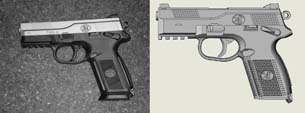NVision Helps Produce Handgun Replica Three Months Faster
Laser scanning saves Airsoft gun replica maker time.
Latest News
November 29, 2010
By DE Editors
 |
Soft Air USA used NVision’s laser scanning services to save three months in getting an Airsoft replica of FN Herstal’s FNP9-17 handgun to market. Soft Air’s previous process involved making silicon molds of real guns and using the molds to create injection molds that in turn make the replica Airsoft guns. Laser scanning eliminates the need for manual touchup of the silicon mold and the resulting CAD model of the real gun can then be electronically sent to manufacturers in Asia.
“Airsoft” refers to a specific type of replica gun that shoots lightweight plastic pellets at a muzzle velocity of less than 600 ft. per second. The combination of the light projectile and relatively low muzzle velocity means Airsoft guns are generally considered safe when used with safety equipment such as protective eyeware. Soft Air USA has licenses from gun manufacturers such as Smith & Wesson, Colt, Sig Sauer, IMI (Uzi), Mauser, Thompson and Kalishnikov.
The FNP-9 is a polymer-framed pistol that weights 25 ounces and has a 16+1 magazine capacity.
“The FNP-9 handgun has never been done as an Airsoft gun in the past,” says John Steele, president of Soft Air USA. “We wanted to make as accurate a reproduction of the gun as is humanly possible.”
In the past, Soft Air has reproduced guns by first making a silicon mold of the actual gun. One problem with this approach was that the gun used as the master was destroyed in the process. Another problem was that the silicon mold typically had many imperfections such as bubbles that needed to be fixed by hand. This process took a considerable period of time. Also, the mold had to be shipped to contract manufacturers in Asia that build the replica guns, which took additional time.
Soft Air contracted with NVision’s Engineering Service division to make a laser scan of the gun. Laser scanning works by projecting a line of laser light onto the surfaces to be measured, while a camera continuously triangulates the changing distance and profile of the laser line as it sweeps along. A computer translates the video image of the line into accurate 3D coordinates of the object’s geometry. NVision engineers create a point cloud consisting of millions of points and use the scan data to create a parametric solid model. The resulting CAD file is provided to Soft Air USA.
“The digital file produced by NVision duplicates every detail of the original gun with outstanding accuracy,” Steele says . “This eliminates the time that was previously spent in manually correcting the silicon mold. We are also able to send the CAD file electronically to our manufacturing partners, which eliminates shipping time. Laser scanning helped us get this new product to market three months sooner than would have been possible using our previous methods. It also helps us attain a higher level of accuracy than was possible in the past. NVision’s laser scanning services help us achieve a significant competitive advantage by getting to market faster with a better product.”
For more information, visit NVision, Inc.
Sources: Press materials received from the company and additional information gleaned from the company’s website.
Subscribe to our FREE magazine, FREE email newsletters or both!
Latest News
About the Author
DE’s editors contribute news and new product announcements to Digital Engineering.
Press releases may be sent to them via [email protected].






